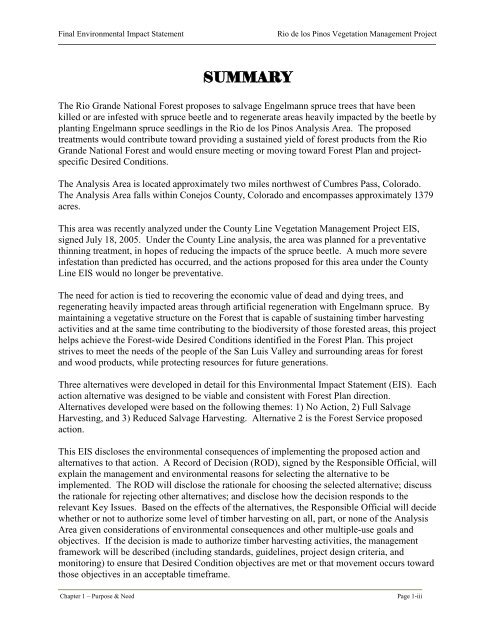Final Environmental Impact Statement Rio de los Pinos Vegetation ...
Final Environmental Impact Statement Rio de los Pinos Vegetation ...
Final Environmental Impact Statement Rio de los Pinos Vegetation ...
Create successful ePaper yourself
Turn your PDF publications into a flip-book with our unique Google optimized e-Paper software.
<strong>Final</strong> <strong>Environmental</strong> <strong>Impact</strong> <strong>Statement</strong> <strong>Rio</strong> <strong>de</strong> <strong>los</strong> <strong>Pinos</strong> <strong>Vegetation</strong> Management Project<br />
SUMMARY<br />
The <strong>Rio</strong> Gran<strong>de</strong> National Forest proposes to salvage Engelmann spruce trees that have been<br />
killed or are infested with spruce beetle and to regenerate areas heavily impacted by the beetle by<br />
planting Engelmann spruce seedlings in the <strong>Rio</strong> <strong>de</strong> <strong>los</strong> <strong>Pinos</strong> Analysis Area. The proposed<br />
treatments would contribute toward providing a sustained yield of forest products from the <strong>Rio</strong><br />
Gran<strong>de</strong> National Forest and would ensure meeting or moving toward Forest Plan and projectspecific<br />
Desired Conditions.<br />
The Analysis Area is located approximately two miles northwest of Cumbres Pass, Colorado.<br />
The Analysis Area falls within Conejos County, Colorado and encompasses approximately 1379<br />
acres.<br />
This area was recently analyzed un<strong>de</strong>r the County Line <strong>Vegetation</strong> Management Project EIS,<br />
signed July 18, 2005. Un<strong>de</strong>r the County Line analysis, the area was planned for a preventative<br />
thinning treatment, in hopes of reducing the impacts of the spruce beetle. A much more severe<br />
infestation than predicted has occurred, and the actions proposed for this area un<strong>de</strong>r the County<br />
Line EIS would no longer be preventative.<br />
The need for action is tied to recovering the economic value of <strong>de</strong>ad and dying trees, and<br />
regenerating heavily impacted areas through artificial regeneration with Engelmann spruce. By<br />
maintaining a vegetative structure on the Forest that is capable of sustaining timber harvesting<br />
activities and at the same time contributing to the biodiversity of those forested areas, this project<br />
helps achieve the Forest-wi<strong>de</strong> Desired Conditions i<strong>de</strong>ntified in the Forest Plan. This project<br />
strives to meet the needs of the people of the San Luis Valley and surrounding areas for forest<br />
and wood products, while protecting resources for future generations.<br />
Three alternatives were <strong>de</strong>veloped in <strong>de</strong>tail for this <strong>Environmental</strong> <strong>Impact</strong> <strong>Statement</strong> (EIS). Each<br />
action alternative was <strong>de</strong>signed to be viable and consistent with Forest Plan direction.<br />
Alternatives <strong>de</strong>veloped were based on the following themes: 1) No Action, 2) Full Salvage<br />
Harvesting, and 3) Reduced Salvage Harvesting. Alternative 2 is the Forest Service proposed<br />
action.<br />
This EIS disc<strong>los</strong>es the environmental consequences of implementing the proposed action and<br />
alternatives to that action. A Record of Decision (ROD), signed by the Responsible Official, will<br />
explain the management and environmental reasons for selecting the alternative to be<br />
implemented. The ROD will disc<strong>los</strong>e the rationale for choosing the selected alternative; discuss<br />
the rationale for rejecting other alternatives; and disc<strong>los</strong>e how the <strong>de</strong>cision responds to the<br />
relevant Key Issues. Based on the effects of the alternatives, the Responsible Official will <strong>de</strong>ci<strong>de</strong><br />
whether or not to authorize some level of timber harvesting on all, part, or none of the Analysis<br />
Area given consi<strong>de</strong>rations of environmental consequences and other multiple-use goals and<br />
objectives. If the <strong>de</strong>cision is ma<strong>de</strong> to authorize timber harvesting activities, the management<br />
framework will be <strong>de</strong>scribed (including standards, gui<strong>de</strong>lines, project <strong>de</strong>sign criteria, and<br />
monitoring) to ensure that Desired Condition objectives are met or that movement occurs toward<br />
those objectives in an acceptable timeframe.<br />
Chapter 1 – Purpose & Need Page 1-iii
















